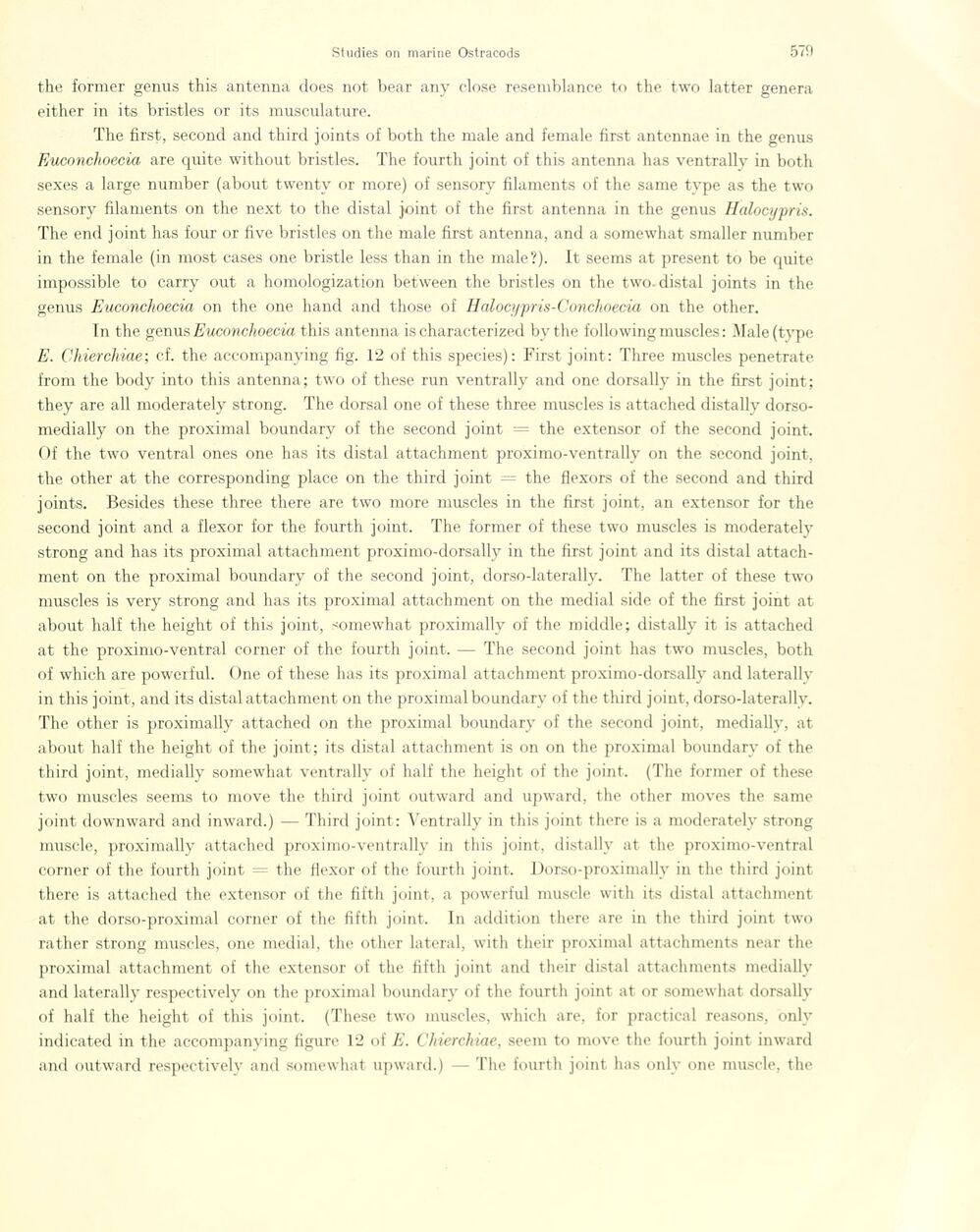
Full resolution (JPEG) - On this page / på denna sida - Sidor ...

<< prev. page << föreg. sida << >> nästa sida >> next page >>
Below is the raw OCR text
from the above scanned image.
Do you see an error? Proofread the page now!
Här nedan syns maskintolkade texten från faksimilbilden ovan.
Ser du något fel? Korrekturläs sidan nu!
This page has never been proofread. / Denna sida har aldrig korrekturlästs.
the former genus this antenna does not bear any close resemblance to the two latter genera
either in its bristles or its musculature.
The first, second and third joints of both the male and female first antennae in the genus
Euconchoecia are quite without bristles. The fourth joint of this antenna has ventrally in both
sexes a large number (about twenty or more) of sensory filaments of the same type as the two
sensory filaments on the next to the distal joint of the first antenna in the genus Halocypris.
The end joint has four or fi ve bristles on the male first antenna, and a somewhat smaller number
in the female (in most cases one bristle less than in the male?). It seems at present to be quite
impossible to carry out a homologization between the bristles on the two distal joints in the
genus Euconchoecia on the one hånd and those of Halocypris-Conchoecia on the other.
In the gémis,Euconchoecia this antenna is characterized by the following muscles: Male (type
E. Chierchiae; cf. the accompanying fig. 12 of this species): First joint: Three muscles penetrate
from the body into this antenna; two of these run ventrally and one dorsally in the first joint;
they are all moderately strong. The dorsal one of these three muscles is attached distally
dorso-medially on the proximal boundary of the second joint = the extensor of the second joint.
Of the two ventral ones one has its distal attachment proximo-ventrally on the second joint,
the other at the corresponding place on the third joint = the flexors of the second and third
joints. Besides these three there are two more muscles in the first joint, an extensor for the
second joint and a flexor for the fourth joint. The former of these two muscles is moderately
strong and has its proximal attachment proximo-dorsally in the first joint and its distal
attachment on the proximal boundary of the second joint, dorso-laterally. The latter of these two
muscles is very strong and has its proximal attachment on the medial side of the first joint at
about half the height of this joint, somewhat proximally of the middle; distally it is attached
at the proximo-ventral corner of the fourth joint. — The second joint has two muscles, both
of which are powerful. One of these has its proximal attachment proximo-dorsally and laterally
in this joint, and its distal attachment on the proximal boundary of the third joint, dorso-laterally.
The other is proximally attached on the proximal boundary of the second joint, medially, at
about half the height of the joint; its distal attachment is on on the proximal boundary of the
third joint, medially somewhat ventrally of half the height of the joint. (The former of these
two muscles seems to move the third joint outward and upward, the other moves the same
joint downward and inward.) — Third joint: Ventrally in this joint there is a moderately strong
muscle, proximally attached proximo-ventrally in this joint, distally at the proximo-ventral
corner of the fourth joint = the flexor of the fourth joint. Dorso-proximally in the third joint
there is attached the extensor of the fifth joint, a powerful muscle with its distal attachment
at the dorso-proximal corner of the fifth joint. In addition there are in the third joint two
rather strong muscles, one medial, the other latéral, with their proximal attachments near the
proximal attachment of the extensor of the fifth joint and their distal attachments medially
and laterally respectively on the proximal boundary of the fourth joint at or somewhat dorsally
of half the height of this joint. (These two muscles, which are, for practical reasons, only
indicated in the accompanying figure 12 of E. Chierchiae, seem to move the fourth joint inward
and outward respectively and somewhat upward.) — The fourth joint has only one muscle, the
<< prev. page << föreg. sida << >> nästa sida >> next page >>